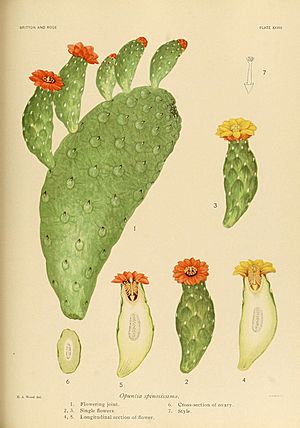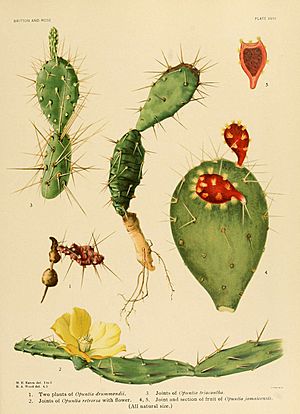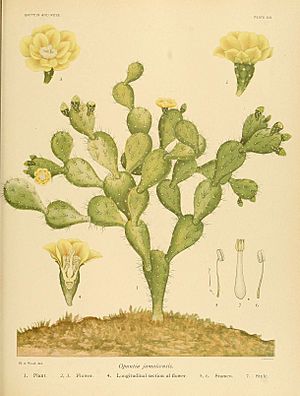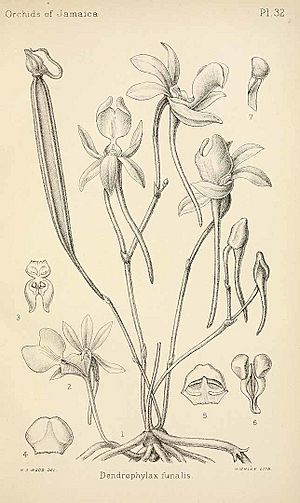Helen Adelaide Wood facts for kids
Quick facts for kids
Helen Adelaide Wood
|
|
|---|---|
| Born |
17 August 1860
|
| Died | 25 November 1927 (aged 67) |
| Nationality | English |
| Occupation | Botanical illustrator |
Helen Adelaide Wood (born August 17, 1860 – died November 25, 1927) was a talented British botanical artist. She was also a scientific illustrator. Helen is most famous for her amazing collection of illustrations. These are kept at the Natural History Museum of Jamaica.
She also drew pictures for a big book called The Cactaceae. This book was about different types of cacti. It was published between 1919 and 1923. The Natural History Museum of Jamaica has a special collection of her art. It's so important that it's on the UNESCO Memory of the World Register. This register lists important historical items. Helen's artwork is also at the National Museum of Natural History. She was one of the first women to work at a museum in the Caribbean. She worked at the Natural History Museum of Jamaica from 1912 to 1927.
Contents
Helen Wood's Life Story
Helen Adelaide Wood was the daughter of John Jarrett Wood. Her mother was Rachel Ann Wood. Her father wrote a book about Jamaica. It was called Jamaica: Its History, Constitution, and Topographical Description With Geological and Meteorological Notes Compiled for the Use of Schools.
Becoming an Artist
We don't know much about Helen's early life. But she learned the skills to become an artist. Many female artists back then learned from family. Some taught themselves. It's not clear how Helen learned her art skills. However, her father was a scientist. This might have helped her find a good teacher.
Her Active Years
Helen was active as an artist in the late 1800s and early 1900s. During this time, it was hard for female artists. They often struggled to earn enough money. Helen never married. So, her art was likely her main way to make a living. Other female artists, like Elizabeth Blackwell, also used their art to support themselves.
It was tough for any female artist to become very successful then. Even famous artists needed male support to show their work. But Helen was lucky. Her drawings were shown in important plant journals. She worked with well-known plant scientists. These included William Fawcett and Nathaniel Lord Britton.
Where Her Art Appeared
Some of Helen's first recorded works are from 1904. They appeared in a journal called Transactions of the Linnean Society of London, 2nd series: Botany. One example is her drawing of an Orchidaceae. Later, her work was in Flora of Jamaica volumes 1, 3, 4, 5, and 7. She also contributed to The Cactaceae volumes 1, 2, and 3.
In the first Flora of Jamaica book, she was thanked by name. But in other books, she wasn't mentioned in the introduction. However, you can find her signature near her drawings. She often signed as H. A. Wood or simply Miss Wood. Sometimes, she wasn't credited at all, even if she contributed.
Working at the Museum
Later in her life, Helen worked at the Natural History Museum of Jamaica. We don't know much about her time there. But the museum is now home to many of her artworks. About 480 of her original pieces have been kept there since she passed away.
Her collection includes different art styles. She used charcoal, ink, and watercolor. Most of her illustrations are of plants. She also drew a few birds. All the subjects were found in Jamaica. Some of the plants she drew no longer exist in nature. This makes her collection even more valuable. Other places that have her work include the Natural History Museum in London. The Smithsonian Institution also has some of her pieces. These came from Flora of Jamaica and The Cactaceae.
Helen's Unique Art Style
Helen Wood's art style was very special. Compared to other artists of her time, her drawings were very accurate. They were also straightforward. But she still captured the beauty of the plants she drew.
Detailed Plant Depictions
A lot of her work shows the whole plant. But it also includes close-ups of flowers. Sometimes, she even drew plants sliced in half. This helped show their inner parts. In other drawings, she focused on just one part of the plant. Even then, she would redraw small sections with more detail. This is like in The Cactaceae (Plate XIX).
Her focused and detailed plant drawings remind us of Georg Dionysius Ehret. He was a botanist and artist from the 1700s. Helen might have been inspired by his later works. These works often centered on one plant form. But they also had very detailed drawings of small pieces next to the main drawing.
She also used methods similar to Robert Hooke. He used a microscope to get detailed images. Helen's way of drawing a sliced plant part might have come from Nehemiah Grew. He changed Hooke's method to study plant structures.
Simplicity and Scientific Accuracy
Helen's work can also be compared to older artists like Joris Hoefnagel. He was active in the late 1500s. Both artists showed beauty and detail in their work. But Hoefnagel often combined many plants in one drawing. Helen's drawings usually only showed close-ups of the plant itself. Sometimes, she included the ground around it.
Many artists, especially in earlier times, used fancy writing around their art. Helen's art was much simpler. She labeled her drawings in a very scientific way. Sometimes, she didn't label them at all. When she did, she used short text and numbers. This kept the drawing clear and neat. The detailed descriptions were usually written by the botanists. All of Helen's work was done with famous botanists. You can also see her signature below each of her pieces.






